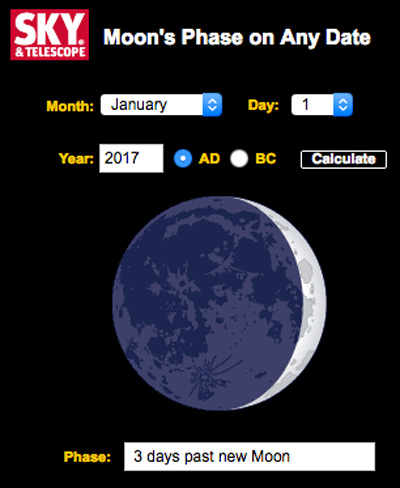Launch our Interactive Phases of the Moon Tool!
Will moonlight interfere with nighttime observing when you plan to take vacation next summer? What was the Moon's exact phase on the day you were born? When's the next opportunity to photograph a young crescent Moon?
Sky & Telescope's interactive tool will show the Moon's phase for any date from 4000 BC to AD 8000.
How to Use the Phases of the Moon Tool
The tool will open with the current phase of the Moon, including a text description at the bottom.
To obtain the Moon's phase on any other date, select the month and day from the dropdown menus and type the year. Select AD or BC, then click Calculate.
Try This: Moon Phase Experiments

Want to experiment? Try these examples, all of which were described in more detail in past articles from Sky & Telescope:
- Bobbing in a lifeboat in the predawn hours of April 15, 1912, Titanic survivor Lawrence Beesley described "the thinnest, palest of moons" rising over the ocean to the east. The previous evening, the Moon's absence from the sky had made it hard for lookouts to spot the iceberg that sank the ship. (S&T: October 1993, page 79)
- During World War II, Allied prisoners held at Stalag Luft III picked the "dark of the Moon" — March 24, 1944 — for their daring breakout to minimize the chance of being spotted by German guards. Their exploits are the subject of the classic 1963 movie The Great Escape. (S&T: April 1994, page 86)
- Thales of ancient Greece earned his reputation by successfully predicting the total solar eclipse of May 28, 585 BC. Our Moon Box does not show eclipses, but it does indicate that the Moon was exactly new on that date. (S&T: May 1994, page 36)
- At the start of the American Revolution, Paul Revere made his famous "midnight ride" on April 18, 1775, with bright moonlight to guide the way — a fact mentioned five times in the stirring poem of Henry Wadsworth Longfellow that begins, "Listen, my children, and you shall hear . . ." (S&T: April 1992, page 437)
- Discover which month will be the next to host a Blue Moon.
Note that our Phases of the Moon tool uses the Gregorian calendar after 1582 and the Julian calendar before that year.
If you see any problems with this tool, or any of our interactive tools, please send an email to [email protected].
 9
9
Comments
popoykida
April 13, 2017 at 1:26 pm
i try the moon's phase on the date of my birthday,i calculate it,the result is.full moon.
when the times i was born is full moon,there's have a effect on my childhood values?or is this ordenary.
You must be logged in to post a comment.
Roger W. SinnottPost Author
April 5, 2020 at 9:19 am
Just a lucky coincidence, I think! Quite a few books and papers, scientific and otherwise, have looked for correlations between lunar phases and human behavior. For example, papers by Walter and Abraham Menaker in the American Journal of Obstetrics and Gynecology (1959 and 1967), using a massive database, found that slightly more births occur when the Moon is full than at other phases. There is no sound evidence that this influences your personality later. However, there are persistent reports (over the centuries) that humans become more aggressive around the time of full Moon, and crime rates go up. For much more on this subject, see psychiatrist Arnold L. Lieber's 1996 book, How the Moon Affects You.
You must be logged in to post a comment.
Lyn
August 27, 2017 at 5:48 pm
Just used it and it works out great!!
You must be logged in to post a comment.
heathro
December 30, 2017 at 9:15 pm
When is the next full moon?
You must be logged in to post a comment.
Monica Young
January 3, 2018 at 1:50 pm
Hi Heathro, Since you're writing on December 30th, you may already have seen the full Moon on January 1st. The next will be on January 31st. You can always find the phase of the Moon using our online tool: http://skyandtelescope.org/observing/celestial-objects-to-watch/the-phase-of-the-moon/
You must be logged in to post a comment.
Pencil BFB
January 19, 2020 at 8:19 am
What's the need to say "You've entered a year before AD 100" when entering a year from AD 1 to 100?
You must be logged in to post a comment.
Yellville443
May 19, 2021 at 6:35 pm
Could you inform the orbital period used in the program. I understand the current synodic period of 29.53 days, but does the program use a calculated change of orbital speed throughout the years of of its calculation?
You must be logged in to post a comment.
Roger W. SinnottPost Author
May 21, 2021 at 3:24 pm
Hi Yellville443 -- You are right that the Moon's motion is extremely complicated. For example, the time from one new Moon to the next can be as short as 29 days 6 hours, or as long as 29 days 20 hours. A great deal of information on calculating the Moon's position, including many dozens of perturbation terms, can be found in Jean Meeus's Astronomical Algorithms (Willmann-Bell, 1991, 1998). Our Moon-phase tool uses only the four most important perturbation terms. It also takes into account some very gradual changes in the Moon's orbit over the centuries. This is enough to ensure the tool will maintain accuracy to the nearest day, all the way back to 4000 B.C.
You must be logged in to post a comment.
You must be logged in to post a comment.